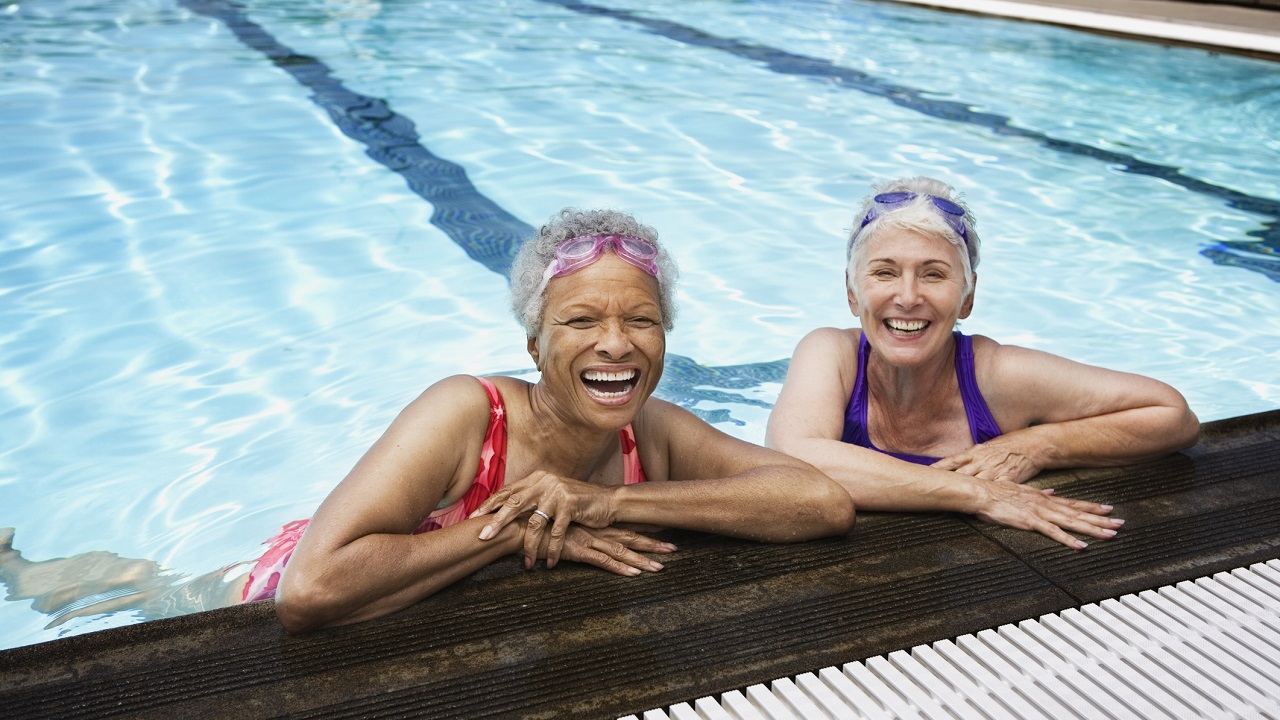“I’d go down right now and go surfing… if I had someone to help me get back out,” says 75-year-old Margo Bouer. A former psychiatric nurse, she fully recognizes the importance of her strong connection with the water. For her, time spent in the pool or ocean means temporary relief from the shaking and nausea caused by advanced multiple sclerosis (MS).
Bouer is a member of the Aquadettes, a seniors-only synchronized swimming team based out of Laguna Woods Village, a retirement community in Orange County, Calif. Composed entirely of women ranging in age from their early 60s to upper 80s, the Aquadettes has garnered a great deal of media attention over the years and serves as an embodiment of the healing power of aquatic exercise for seniors. Bouer was even the subject of a short documentary entitled Aquadettes: On Life, Death and Synchronized Swimming.
Many seniors like Bouer find aquatic workouts to be an excellent way of improving their mental and physical well-being while enjoying relief from symptoms associated with conditions like arthritis and circulatory problems. The low-impact nature of aquatic exercise can be a boon for anyone who suffers from chronic medical issues or age-related decline.
Benefits of Water Exercise for Seniors
While weight loss and cardiovascular endurance are common benefits of any type of physical activity, moving while partially or fully submerged in the water offers some of the following advantages that set aquatic exercise apart from land-based activity.
Improved Balance
A person’s risk of falls and fall-related injuries increases with age due to factors like muscular weakness, joint pain, osteoporosis and changes in vision. Exercising in water that is at least waist deep allows an elderly person to work on their coordination and balance while aided by the water’s natural resistance and support.Increased Strength
Trying to make through water is a form of resistance training that can help build endurance and muscle strength in the core and extremities without the need for special equipment.Minimal Impact
The buoyancy factor makes swimming and water exercise among the most injury-free sports. This is an especially safe way of working out without the risk of falling. If a senior does lose their balance, the water will “catch” them, especially if they are wearing a life vest.
Pamela Bartlo, PT, DPT, a board certified specialist in cardiopulmonary physical therapy and clinical associate professor at D’Youville College in Buffalo, N.Y., also points out that arthritis pain often inhibits an older person’s ability to exercise on dry land. But, she says that working out in the water puts significantly less stress on joints, enabling elders to exercise pain-free for longer periods of time.
The Social Side of Exercising at the Pool
Socialization is an integral benefit of many types of physical activity, and aquatic exercise is no exception. Research suggests that social interaction and support are key motivators compelling elderly people to begin and maintain an exercise program.
Opportunities for socialization during a water workout are practically endless. Group exercise classes provide an ideal opportunity to gab and make friends. Seniors can also take a page out of the competitive swimming handbook and partake in “social kick.” Social kick is a time during practice when swimmers use kickboards to swim laps side-by-side so they can exercise while chit-chatting.
Check With the Doctor Before Diving In
Despite its many advantages, working out in the water isn’t for everyone. Bartlo advises anyone who is considering starting a new exercise regimen, aquatic or otherwise, to consult with their doctor first, since some workouts can be detrimental to seniors with certain medical conditions.
For example, people with high blood pressure, congestive heart failure, and breathing disorders like emphysema and asthma, should not exercise in water that hits above the waist.
“Deeper water can increase the pressure placed on a person’s cardiovascular system, making it harder to breathe and causing blood pressure to rise,” warns Bartlo.
Physical Activity and the Importance of Goal-Setting
With studies touting the role of physical fitness in disease prevention coming out daily, it’s more important than ever for seniors to remain physically active. Whether one chooses to participate in synchronized swimming, water aerobics, water yoga or aqua-jogging, perhaps the most compelling benefit of an exercise program is the end goal.
For seniors with chronic diseases, goal-setting may seem fruitless, but it is crucial. “It’s hard to know what the next goal should be, other than staying alive,” Bouer admits. But, she emphasizes that living for doctor’s appointments is not really living at all. Having a real goal to work towards, whether big or small, can give seniors a valuable sense of purpose.
For Bouer and her fellow Aquadettes, staying alive while maintaining their physical fitness may help them realize a very unique goal. When they turn 90 years old, each Aquadette is offered the opportunity to perform a solo during the group’s yearly water show performance—a tradition that celebrates purposeful longevity.
“I’ve got to remember that I want to do those things,” Bouer explains. “Because, if you come to a point where you don’t want to do any of those things, then where is life?”
